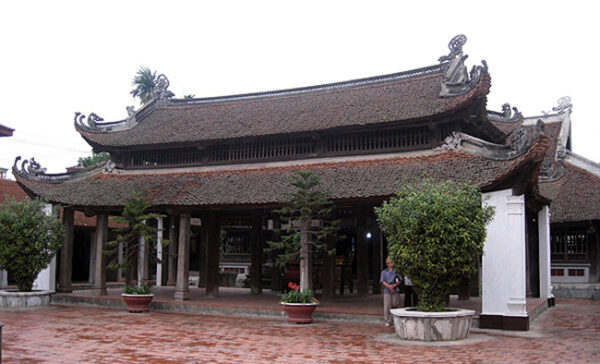
Ha Hiep communal house in Lien Hiep commune, Phuc Tho district, Hanoi city worships Hoang Dao, a general who participated in the uprising of Hai Ba Trung in the years 40 – 43. Later, General Hoang Dao returned to Bai Van area (Ha Hiep) in the village. His grave is situated there at the present. Ha Hiep villagers built a communal house and worship him at Hau cung. Ha Hiep communal house is also known as Lien Hiep communal house or Ke Hiep communal house. The communal house was restored in the 17th century, facing the southwest, including Nghi mon, Tien te, Dai dinh, Ta vu, Huu vu and ancillary works.
Nghi Mon
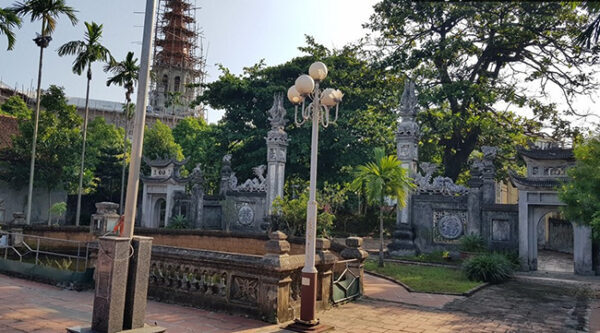
The inside of Nghi mon in Ha Hiep communal house, Phuc Tho, Hanoi
In front of Nghi mon is a pond.
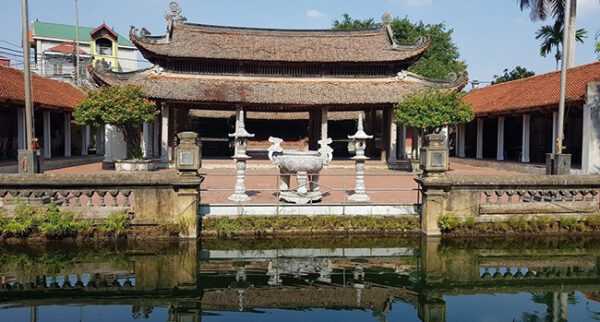
Nghi mon includes 4 pillars. The two middle pillars are high; the top of the pillar is decorated with four phoenixes; the upper body is decorated with lantern boxes; the lower body is decorated with the opposite sentence box. The two lateral plinths are low; the top of the pillar is decorated with the small lion; the upper body is decorated with lantern boxes; lower body is decorated with the opposite sentence box. All 4 pillars are tied in the middle of the base.
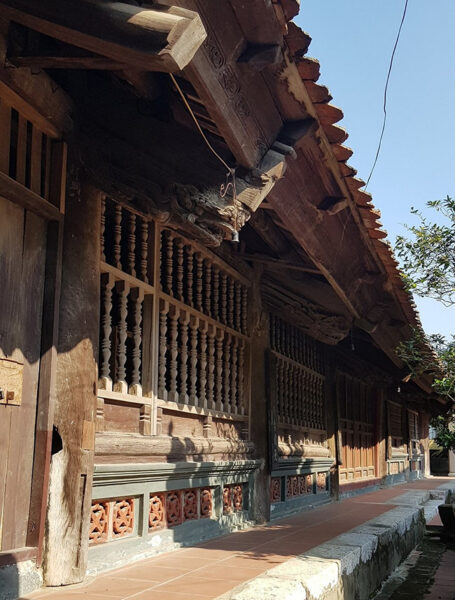
The front of Chinh dien of the Ha Hiep communal house in Phuc Tho, Hanoi
The main gate is located between the two high pillars. A wall is built between the high pillars and the low pillars, decorated with dragons. Two arched auxiliary gates with eight 2-storey roofs are installed next to the pillars. A newly-built semicircular lake and a communal court is behind Nghi mon.
Tien te
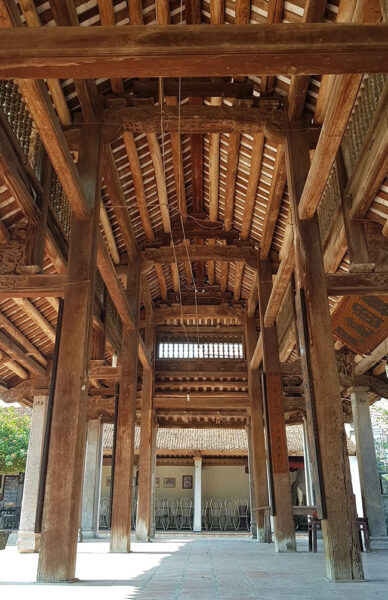
The inside of Tien te building in of Ha Hiep communal house, Phuc Tho, Hanoi
Tien te or Bai duong includes 3 compartments, 2 wings, and 8 overlapped roof. The building has 4 rows of square columns; the two middle rows are made of wood and the two outer rows are made of stone, being open to all 4 sides. Tien te building was rebuilt in the 20th century. Ta vu and Huu vu are situated on two sides of Tien te building. These two buildings were also rebuilt in recent years.
Dai dinh
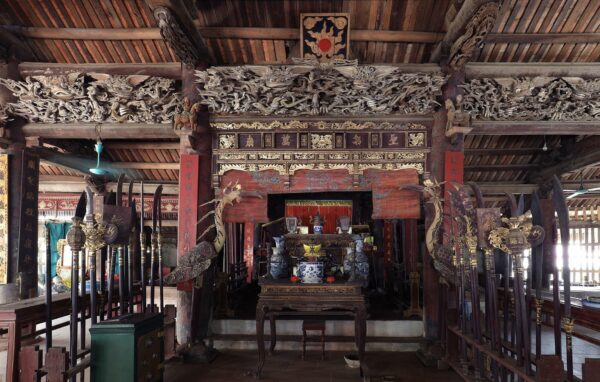
The front of Hau cung in Ha Hiep communal house, Phuc Tho, Hanoi
Dai dinh is in the shape of “dinh” letter or T letter, consisting of Chinh dien and Hau cung, lying on a platform one step above the courtyard, being built on the 17th century (around 1663). Chinh dien consists of 5 compartments, 2 wings, 6 rows of columns, with overlapped structure.
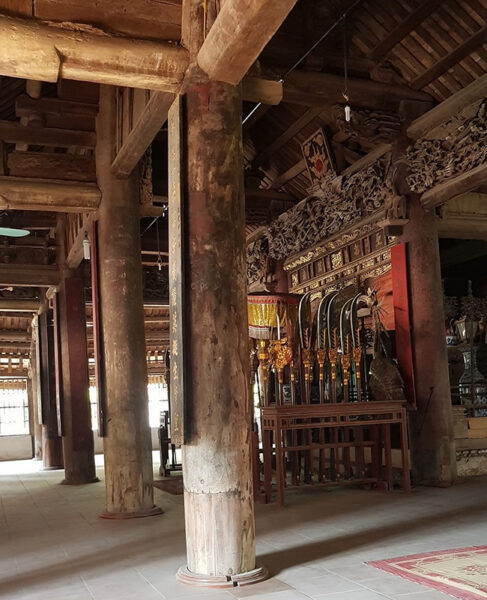
The interior of Chinh dien, in front of Hau cung, Ha Hiep communal house, Phuc Tho, Hanoi
The old communal house had the following structure: for the middle compartment, the tiled floor was placed on the ground; for the remaining compartments, the floor on both sides was made of wooden in the form of stilt-house (where dignitaries in the village meet), and placed about 0.8m above the ground; on the facade, the space under the floor was decorated with openings. Nowadays, the wooden floor is no longer retained, and Bat Trang tiled floor is used instead; however, we can still see the openings of floor supporting beam at the foot of the column. Currently, the gable and the back of the communal house are mainly covered by open wooden bars.
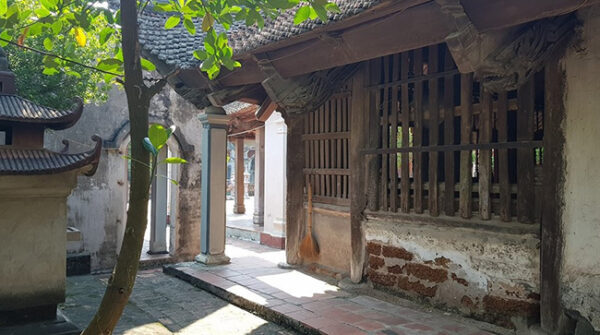
The gable of Chinh dien in Ha Hiep communal house, Phuc Tho, Hanoi
Hau cung is located in the central position, placed vertically, having 2 roofs, perpendicular to the roof of Chinh dien. Hau cung is placed on a platform 2 steps above the ground of Chinh dien (equal to the level of the old wooden floor). In 3 compartments in front of Hau cung, there are elaborate carvings of Fairy and Dragon. Inside Hau cung is a solemn and sacred place, where the village’s tutelary god worshipping throne, sacred objects and worshiping objects are placed. Hau cung is closed all year, except for festivals.
Carving art
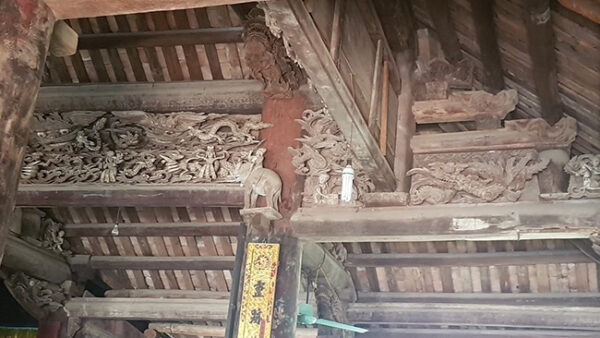
Decorative carvings inside Ha Hiep communal house, Phuc Tho, Hanoi
Like other famous communal houses in Doai region, Ha Hiep, Phuc Tho, there are more than 20 decorative carvings at dau du, con, xa nach, bay, dau, van nong, van la de, con ruong, vi noc, etc. which are created through technique of cham long, cham bong kenh, cham noi, cham thung. In addition, the artistic decoration themes are also shown on the relics such as edicule, incense-table, dragon throne.
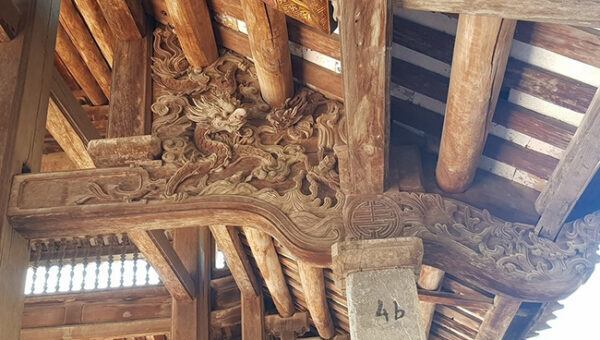
Decorations inside Tien te building in Ha Hiep communal house, Phuc Tho, Hanoi
Ha Hiep communal house can be considered a museum of folk wood carving art, telling cultural stories, expressing outstanding life events of the community, the nature and the faith of people. There are at least three basic types of topic: the earth and the dream-land; Nature; Daily life.
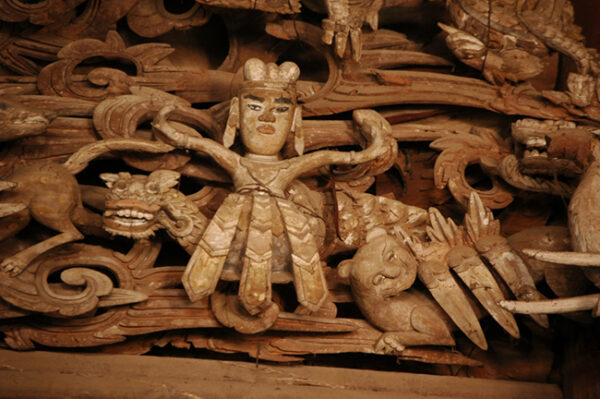
Carving work: Fairy riding a dragon in Ha Hiep communal house, Phuc Tho, Hanoi
Regarding the earth and the dream-land: Some carvings reflect the consolidation between man and nature, and between the earth and the dream-land. Some carvings represent fairy spreading her arms as if it is her wings, as if she is landing on earth to enjoy joy on earth. Some carvings depict a celestial man riding a dragon and landing on earth or maybe a god riding a dragon up to the sky.
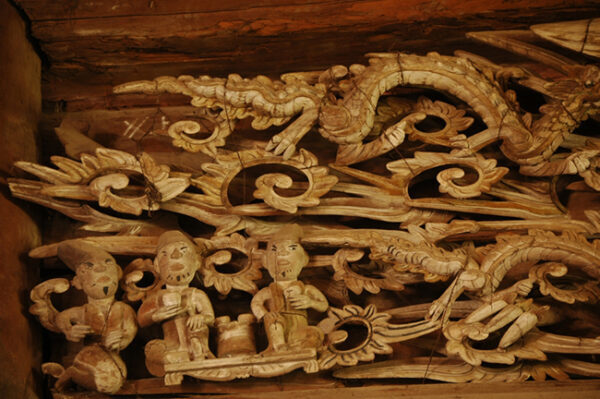
The carving work: Drinking, Ha Hiep Communal House, Phuc Tho, Hanoi
Regarding nature: There are countless carvings from mascots such as Long (Dragon), Ly (Unicorn), Quy (Turtle), Phung (Phoenix), phoenixes, to animals associated with legend like dragon carp, especially iguana or python, a rare image in communal houses of the Doai region.
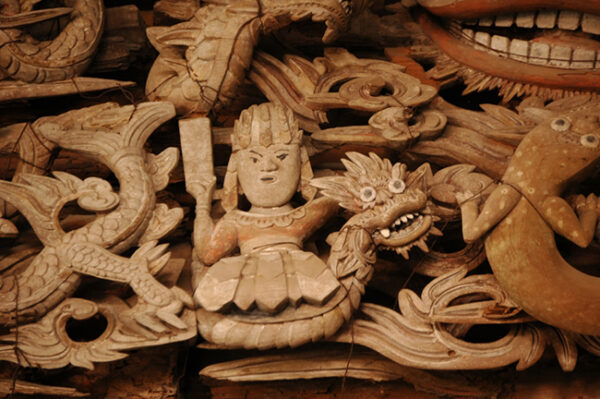
Fairy and mascot animal carvings, including dragon carp, dragon, iguana, Ha Hiep communal house, Phuc Tho
The image of dragon and dragon nest playing a key role is vividly carved on dau du, xa, bay and wooden wall panels of the communal house interior. In the communal house, there are carvings of plants, twisted clouds interwoven with mascots and people.
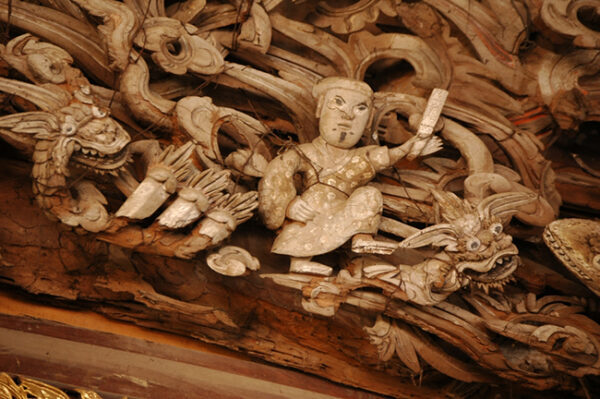
The carving work: A mandarin is riding a dragon, Ha Hiep communal house, Phuc Tho, Hanoi
Regarding the daily life, carving works show vividly the image of human being playing chess, drinking wine, wrestling, dancing, playing drums, fighting buffalo, riding horse, holding chicken to the fighting place, etc.; people and customs such as Grave of the dragon’s jaw; the image of ordinary people in different regions who are recognized through faces, costumes, such as statues with bare heads, hats, towels, holding items.
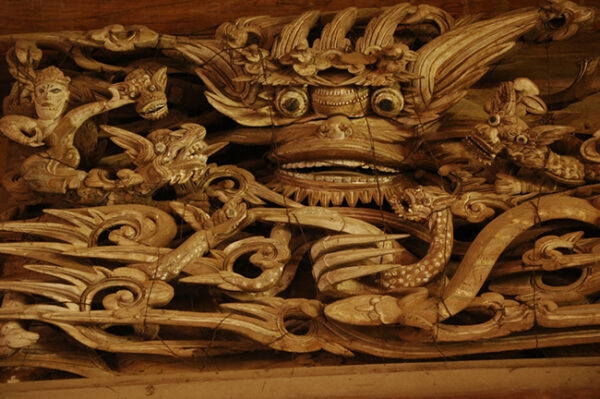
The carving work “Dragon and iguana nest”, Ha Hiep communal house, Phuc Tho, Hanoi
There is a unique carving work “Hunting”, in which “A foreigner shooting a tiger” shows the image of a foreigner holding a gun and shooting a tiger. In the 17th century, many Westerners such as Portuguese, Dutch, English and French coming to trade and live in Kinh Ky and Pho Hien, Hung Yen. The image of foreigners on the carvings probably depicts the common image at that time. Ha Hiep communal house still retains 27 written ordinations (from Le Trung Hung dynasties to Nguyen dynasties) acknowledging the merits of the great general Hoang Dao.
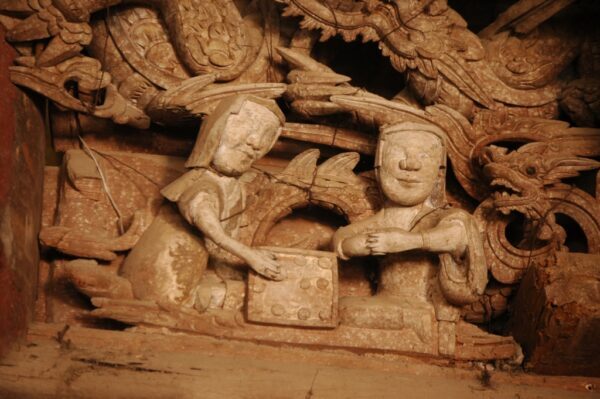
The carving work “Playing chess”, Ha Hiep communal house, Phuc Tho, Hanoi
Ha Hiep communal house festival takes place on February 13th according to lunar calendar, the memorial day of village’s tutelary god Hoang Dao. Ha Hiep communal house in Phuc Tho, Hanoi is not only the cultural and spiritual activity place of local residents, where everyone gathers and meets but also a long-lasting book with carvings template demonstrating the material and spiritual activities of contemporary Vietnamese people.
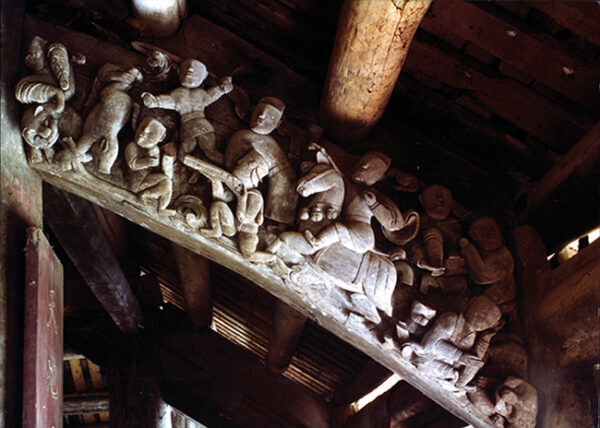
Carving work “Hunting” with the image of a foreigner shooting a tiger, Ha Hiep communal house, Phuc Tho, Hanoi
Ha Hiep communal house is also a valuable work representing the typical art architecture of Vietnamese communal houses.
Dang Tu

